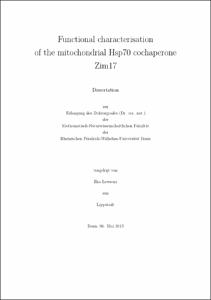Lewrenz, Ilka: Functional characterisation of the mitochondrial Hsp70 cochaperone Zim17. - Bonn, 2013. - Dissertation, Rheinische Friedrich-Wilhelms-Universität Bonn.
Online-Ausgabe in bonndoc: https://nbn-resolving.org/urn:nbn:de:hbz:5n-33343
Online-Ausgabe in bonndoc: https://nbn-resolving.org/urn:nbn:de:hbz:5n-33343
@phdthesis{handle:20.500.11811/5755,
urn: https://nbn-resolving.org/urn:nbn:de:hbz:5n-33343,
author = {{Ilka Lewrenz}},
title = {Functional characterisation of the mitochondrial Hsp70 cochaperone Zim17},
school = {Rheinische Friedrich-Wilhelms-Universität Bonn},
year = 2013,
month = sep,
note = {The mitochondrial zinc finger protein Zim17 belongs to a newly identified class of cochaperones that maintain the function of Hsp70 proteins in mitochondria and plastides of eukaryotic cells, presumably by preventing the aggregation of their respective chaperone partners. However, while its aggregation-preventive function is well demonstrated in vitro, little is known about the influence of the Zim17 interaction on the chaperone activity of mitochondrial Hsp70s (mtHsp70s) and its concurrent effects in the cellular context.
Due to the aggregation-protective character of Zim17, recombinant co-expression with the zinc finger protein allowed the purification of the main yeast mtHsp70 Ssc1 from E.coli cells under native conditions. The purified proteins were used to analyse the influence of Zim17 on the solubility of Ssc1 as well as the character and stability of its binding to the chaperone. Zim17 interacted with Ssc1 as a single molecule but tended to form dimers in the absence of the Hsp70 chaperone. Though the presence of Zim17 improved the solubility of recombinant Ssc1 in E.coli cells, substantial amounts of the Hsp70 chaperone still aggregated, even when Zim17 was expressed in saturated amounts.
To study the effects of a loss of Zim17 function in the cellular environment, novel conditional mutations within the ZIM17 gene of the model organism Saccharomyces cerevisiae were generated. Yeast cells carrying these mutations showed a temperature- sensitive growth phenotype and a tendency to develop respiratory deficits. On fermentable growth media, the mutant cells were prone to loose their respiratory competence and were inviable at elevated temperatures. In these cells, a strong aggregation of the mitochondrial Hsp70 Ssq1 together with a concomitant defect in Fe/S protein biogenesis was observed. In contrast, under respiring conditions, the mitochondrial Hsp70s Ssc1 and Ssq1 exhibited only a partial aggregation. The induction of the zim17 mutant phenotype by subjection to a high temperature treatment lead to a strong import defect for Ssc1-dependent matrix-targeted precursor proteins that correlated with a significantly reduced binding of newly imported substrate proteins to Ssc1. Both in vitro and in vivo approaches point to the conclusion that Zim17 is not primarily required for the maintenance of mtHsp70 solubility. Instead, a functional analysis of the chaperone cycles of Ssc1 and Ssq1 shows that Zim17 directly assists the functional interaction of mtHsp70 with substrate proteins in a J-protein cochaperone-dependent manner.},
url = {https://hdl.handle.net/20.500.11811/5755}
}
urn: https://nbn-resolving.org/urn:nbn:de:hbz:5n-33343,
author = {{Ilka Lewrenz}},
title = {Functional characterisation of the mitochondrial Hsp70 cochaperone Zim17},
school = {Rheinische Friedrich-Wilhelms-Universität Bonn},
year = 2013,
month = sep,
note = {The mitochondrial zinc finger protein Zim17 belongs to a newly identified class of cochaperones that maintain the function of Hsp70 proteins in mitochondria and plastides of eukaryotic cells, presumably by preventing the aggregation of their respective chaperone partners. However, while its aggregation-preventive function is well demonstrated in vitro, little is known about the influence of the Zim17 interaction on the chaperone activity of mitochondrial Hsp70s (mtHsp70s) and its concurrent effects in the cellular context.
Due to the aggregation-protective character of Zim17, recombinant co-expression with the zinc finger protein allowed the purification of the main yeast mtHsp70 Ssc1 from E.coli cells under native conditions. The purified proteins were used to analyse the influence of Zim17 on the solubility of Ssc1 as well as the character and stability of its binding to the chaperone. Zim17 interacted with Ssc1 as a single molecule but tended to form dimers in the absence of the Hsp70 chaperone. Though the presence of Zim17 improved the solubility of recombinant Ssc1 in E.coli cells, substantial amounts of the Hsp70 chaperone still aggregated, even when Zim17 was expressed in saturated amounts.
To study the effects of a loss of Zim17 function in the cellular environment, novel conditional mutations within the ZIM17 gene of the model organism Saccharomyces cerevisiae were generated. Yeast cells carrying these mutations showed a temperature- sensitive growth phenotype and a tendency to develop respiratory deficits. On fermentable growth media, the mutant cells were prone to loose their respiratory competence and were inviable at elevated temperatures. In these cells, a strong aggregation of the mitochondrial Hsp70 Ssq1 together with a concomitant defect in Fe/S protein biogenesis was observed. In contrast, under respiring conditions, the mitochondrial Hsp70s Ssc1 and Ssq1 exhibited only a partial aggregation. The induction of the zim17 mutant phenotype by subjection to a high temperature treatment lead to a strong import defect for Ssc1-dependent matrix-targeted precursor proteins that correlated with a significantly reduced binding of newly imported substrate proteins to Ssc1. Both in vitro and in vivo approaches point to the conclusion that Zim17 is not primarily required for the maintenance of mtHsp70 solubility. Instead, a functional analysis of the chaperone cycles of Ssc1 and Ssq1 shows that Zim17 directly assists the functional interaction of mtHsp70 with substrate proteins in a J-protein cochaperone-dependent manner.},
url = {https://hdl.handle.net/20.500.11811/5755}
}






